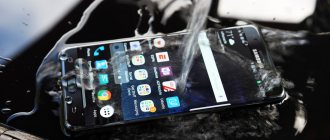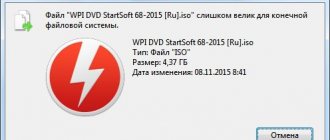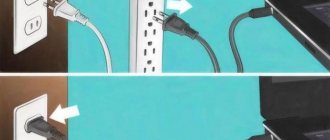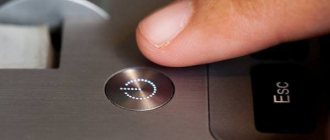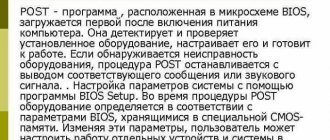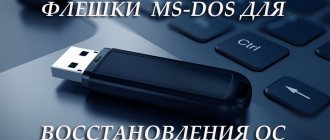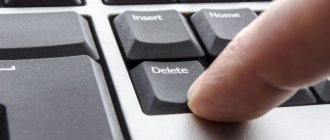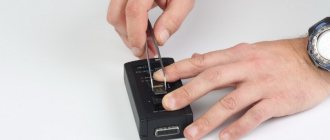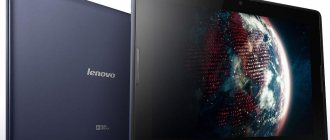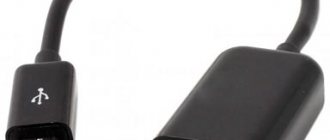What to do if the flash drive in your computer constantly disappears and appears
It is difficult to imagine a modern computer user without the constant and active use of external memory storage devices. The most common of them are USB flash drives. Working with these devices is easy: just insert the drive into the appropriate slot and open a window with the contents. Once work is completed, it is safe to remove the device. However, many users encounter problems in using flash cards, which are often beyond human control. Let's figure out what to do if the flash drive constantly turns on and off when connected to a personal computer. Let's start by identifying the cause.
Today we will talk about how to resolve USB drive connection errors.
What to do if nothing helps?
If you cannot fix the problem yourself, it is recommended to contact the service. As practice shows, most drives of this type cannot be restored. Due to careless use or poor quality, the lifespan of devices is quite short.
All the testing and repair methods described in the article are accessible even to inexperienced users, so it’s worth starting with them.
Let's say you uploaded files to a USB Flash Drive
Safely Remove Hardware”
icon and, instead of disconnecting the flash drive, received
the message
: “
Windows cannot stop the device “Generic Volume” because it is in use
. First, complete (close) all programs and windows that may be using this flash drive that cannot be disconnected.
Of course you can just unplug the USB
drive, ignoring this message. Nothing bad will happen, but for the time being, both the flash drive and the information on it and the motherboard itself may be damaged.
There are special programs that provide USB
drives in “one click” (for example, the convenient
USB Safely Remove
), as practice shows, these programs do not always save.
In such cases, you need to use the following set of instructions sequentially:
1.
Close all running programs and open files.
2.
Call the task manager (
Ctrl + Alt + Delete
, or use
Win + R
to open the command line and enter
taskmgr
→
OK
)
3.
In the Task Manager that opens, select the Processes tab.
4.
Mark
explorer.exe
and click on the “End Process” button
5.
In the window that opens “Do you really want to terminate
explorer.exe”
click “End Process”
6.
Go to the “Applications” tab of the task manager and click on the “ New task..."
7.
Enter
explorer
→
OK 8.
Try removing
the USB Flash Drive
by clicking on the "Safely Remove Hardware" icon. Good luck!
It is difficult to imagine a modern computer user without the constant and active use of external memory storage devices. The most common of them are USB flash drives. Working with these devices is easy: just insert the drive into the appropriate slot and open a window with the contents. Once work is completed, it is safe to remove the device. However, many users encounter problems in using flash cards, which are often beyond human control. Let's figure out what to do if the flash drive constantly turns on and off when connected to a personal computer. Let's start by identifying the cause.
To begin troubleshooting, you need to understand where the problem lies. This or that case leads to different solutions to the problem. Let's divide them into main groups:
- the reason is a computer malfunction;
- The problem is with the external drive itself.
Also, all faults can be divided into software and hardware. Let's consider all the options in more detail.
Computer problems
When you connect a flash drive to a PC, an autorun window should appear, and the drive should be identified in the “My Computer” window, indicating the name and information about the capacity. If the flash drive either disappears or appears in the list of connected external drives, then first check your USB port. It is advisable to connect USB 3.0 flash drives to the appropriate connector, which is marked in blue on all devices.
Insert the drive into another slot. If everything works properly, then the failure is due to a malfunction of the port. If the flash drive does not work in any of the USB connectors, then the problem most likely lies in the ports themselves.
You can check their functionality using other devices, for example, a USB mouse. It happens that the USB ports on the front panel of the system unit do not work due to problems with drivers, and often they are simply not connected to the motherboard. Therefore, also check your flash drive in the ports located on the back of the system unit - there are usually no problems with them if all the drivers are installed.
If the flash drive appears and immediately disappears in any of the slots, try testing the computer together with another external drive. If the media works and starts up properly, the hardware cause of the malfunction should be looked for in the flash card itself.
If the flash drive immediately turns off when connected, the problem may lie both in the media itself and in the computer
What to do if the flash drive spontaneously disappears and appears when used
Since there are many reasons why a flash drive disappears and then appears (reinitialized) during operation, the methods for fixing it vary.
- When connecting a flash drive to a computer, always give preference to the ports that are located on the back of the system unit. Only these ports are directly connected to the computer’s motherboard; all others use cables, the quality of which is not always the best.
- Whenever preparing a flash drive for use, format it only in the device where you will use it. It is also worth remembering that removing a flash drive and inserting it into another device may disrupt the structure of some of the files that are recorded on it. When subsequently returned to the device, it may begin to exhibit instability in operation. This is especially true for smartphones and cameras.
- Always purchase and use flash drives from reputable brands. Long gone are the days when their prices varied significantly in comparison with lesser-known manufacturers. Give preference to flash drives manufactured by SanDisk, Kingston, Samsung and purchase them only in large stores specializing in the sale of computer equipment and peripherals. There they are sold at the lowest price, have the maximum guarantee, and the risk of running into a fake is minimized.
Now you know why a flash drive can become unstable, spontaneously disappear and reappear while working with it. I hope the recommendations above will help you eliminate the problem and never encounter it again.
Problems with the flash drive
We made sure that the hardware of the personal computer is in good working order. Now let's check the map:
- Check the connector for contamination or mechanical damage. If present, they must be carefully removed;
- if the device case is collapsible, then check the chip for overheating. If the board is hotter than usual, then the flash drive will have to be either replaced or repaired.
- The simplest thing is to check the functionality of the flash drive on another computer. If it behaves the same way there, then the problem is clearly its malfunction.
You should make sure that the media does not overheat while connected to the computer
When a flash drive is connected and immediately disconnected, and the reason is hidden in a hardware problem of the personal computer or the media itself, it will not be possible to fix the problem without special skills and equipment. Contact a professional to try to remove all important files from the drive in case of complete failure.
Equipment setup
Removable USB drives and memory cards, which are popularly known as flash drives, are probably the most popular storage media in the world. We carry documents, important files, photographs and even just music, films and pictures on them. In parallel with their popularity, the problems that arise with them are growing. Someone unsuccessfully disconnected the disk during recording, someone's controller malfunctioned, and someone was unlucky and their flash drive died - this also happens. In the latter case, the problem is hardware and it is easier to throw away the device. But if the failure is software, then you can try to fix the situation yourself. In this article I will give several ways to restore a flash drive , or rather its functionality, which I myself have used. If you have your own solutions to the problem, write in the comments, it’s very interesting to know who helped. So, let's go!
The flash drive won't open!
Windows sees the removable drive, but when you try to log in, it displays the error “No access” or “Access denied.” The most common reason is malware distributed through removable media.
The virus creates a file in the root of the disk: “autorun.inf” with instructions for launching the necessary executable files. Moreover, it often happens that the antivirus has already destroyed the infection itself, but the autorun file remains. Check the flash drive with an antivirus program with the latest databases. After this, you need to go to “My Computer”, right-click on the disk and select “Open”. The content will open in a separate window and you will need to delete the autorun.inf file manually.
The disk is not formatted!
The cause may be a memory controller failure. First, try formatting the flash drive in the usual way, through “My Computer”. Did not help? Try doing this through Disk Manager. To get into it in Windows 7 or Windows 8, press the key combination “Win + R” and in the “Run” window type the command diskmgmt.msc. In the manager window that opens, find your flash drive, right-click on it and select the “Format” menu item.
If this does not bring results, try using specialized utilities. For more details, see the article How to format a flash drive.
The flash drive is not detected (USB device is not recognized)
At the same time, the following error appears.
If it is a USB flash drive, then to begin with, simply disconnect the drive and plug it into another USB port. Ideally, it should be plugged directly into the connector on the motherboard. This will eliminate the possibility of a malfunctioning extension cord or connector. Did not help? Then test it on another computer or laptop. If you have an SD, Micro SD or other memory card, then try disconnecting the card reader and connecting it to another USB port. The same? Then you need to check the card reader, it may be faulty. If a removable disk is detected on another computer without problems, try removing the driver on your own. This is done as follows. Go to Windows Device Manager and find the “USB Controllers” section:
Now we need the line “USB storage device”. Right-click on it and select Delete. Disconnect the flash drive from the PC and reboot. Checking the operation of the drive.
Reinstalling the driver didn't work? Let's try to clean the registry branches in which information about the device is stored. First, you need to collect information about it, or more precisely, two parameters: VID - manufacturer identifier PID - device identifier To do this, go back to Device Manager, find “Storage device” there, right-click on it and select the menu item “ Properties". In the window that opens, we are interested in the “Details” tab. In the “Property” list, look for the line “Device ID” or “Device Instance Code”.
The “Value” field should display lines containing the following code:
VID_1005&PID_1113
These are the parameters we are looking for. Now press the Win+R key combination and enter the regedit command. This will launch the Windows Registry Editor. Here we need to find two branches:
HKEY_LOCAL_MACHINE\SYSTEM\CurrentControlSet\Enum\USB HKEY_LOCAL_MACHINE\SYSTEM\CurrentControlSet\Enum\USBSTOR
Each of them will have subfolders. We find those that contain the found identifiers in their names and completely clear the contents. Attention! You are working with the Windows registry, so be extremely careful. After you clear the folders, restart your computer and check the operation of the flash drive.
Another way is to try to give the system a driver from another computer. The main thing is that the versions of Windows on both PCs are completely identical. Here are these two files:
%SystemRoot%\INF\usbstor.inf %SystemRoot%\SYSTEM32\drivers\usbstor.sys
We simply copy them to any working medium (disk, another flash drive, etc.), bring them to us and place them exactly along the same path. Let's reboot and check if we were able to restore the flash drive.
The removable disk is detected, but it says “size 0, occupied 0, free 0.”
This most often accompanies a failure of the memory controller. Only specialized utilities for working with this particular chip model can help. How to find them? You need to start by finding out the VID and PID parameters of your drive model. I have already described above how this is done. There is, however, another option - to use special programs that provide complete information about the gadget - for example, ChipGenius , CheckUDisk or Usbflashinfo .
Then we go to the website flashboot.ru and in the iFlash section we enter VID and PID in the appropriate fields. Launch search.
In the results found, we find our flash drive model and utilities that are suitable for working with its controller. These programs and instructions for working with them can also be found on this site.
If all else fails...
This is also a common occurrence. Some flash drives can be restored or repaired without any problems, while others end up in the trash. But if you are a desperate and determined person, then you can try the last method - switch the controller to test mode without polling the memory. Unfortunately, this solution is only suitable for USB drives; a memory card (SD or Micro SD) cannot be repaired this way. First you have to remove the plastic case and expose the chip. Now turn it with the chip towards you, as in the picture:
There should be a small dot in the corner - this is the key for counting contacts. As a rule, you need to close contacts 29 and 30 (on some models of flash drives you need to close pins 30 and 31 or 31 and 32). This can be done with a needle or pin.
Attention! You do all these actions at your own peril and risk and must understand that you can completely kill the device by burning the chip.
After that, without opening the contacts, plug the flash drive into the USB port. One should be identified as a device and become available for formatting. Only after this can you open the contacts. But do not rush to disconnect the removable disk. After reconnecting it will not work again. You need to use the VID and PID identifiers to find specialized programs on the Flashboot website and use them to restore the flash drive, or rather its firmware.
Software problem
Now let's look at problems that any PC user can solve. If all external drives connected to USB are disconnected from your computer, then you need to start checking with the drivers. Find an archive with drivers for your computer on the Internet or install them from the disk that came with your purchase. It is also worth updating your operating system if you are using a licensed version. Often, developers update software for compatibility, which can cause problems connecting external devices. If, when you connect the media, the operating system detects it as an “unidentified device,” then the problem lies in the drivers. Try to fix it using the diagnostics and troubleshooting wizard provided by Windows OS. As a result of the diagnosis, you will find out the exact cause.
The flash drive keeps turning off and on
The flash drive constantly turns off and on, what could be the problem, now we’ll try to figure it out. The first thing to check is the physical connection. Perhaps the contact in the connector is lost and for this reason the device turns on and off for no reason.
The fact is that USB is a hard-working connector into which many devices are connected, and it could easily be broken, the Host controller could be damaged, etc. To identify the problem, you need to check the flash on another computer.
Why does the flash drive turn on and then turn off immediately?
Viruses
If the problem is not in contact, and the flash drive turns on and turns off immediately anyway, then most likely the memory has been attacked by viruses. Usually one of the fairly common representatives is Clone.win32. I can pick it up from my work computer, from a friend, or even from a mobile device, be it attached to a file. It’s quite easy to get rid of it by opening the screen on your PC and scanning it for viruses. Then, after treatment, perform a full format.
Problems with motherboard software
Often a flash drive turns off and on due to incorrectly installed drivers for this device. The fact is that many memory cards for optimization with a computer immediately install their own driver after connecting. At the same time, the previous version loaded by another flash drive is not deleted, thus a software conflict may arise between them. To fix the problem, you need to manually remove all drivers and connect the flash again.
Power outages
As the PC operates, the power supply gradually changes its parameters, which is explained by the constant increase in load, as well as wear and tear of the control controller of the flash drive itself. Frequent write and read cycles gradually reduce the resource of the device, thereby reducing its operating speed, data transfer quality and other parameters.

